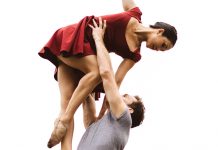
Atlanta Ballet unveiled three ballets last night at Cobb Energy, and while they each depicted disparate subjects, they all displayed an attention to the physicality of dance.
The production, entitled Fusion, is a part of Atlanta Ballet’s gradual move away from more static fare (think Swan Lake) and toward more dynamic original creations that both touch on contemporary topics and utilize contemporary techniques. (As in line with artistic director John McFall’s vision for the company.) It’s a postmodern flourish that will culminate with Ignition at the Alliance in May, which promises all new choreography and world premieres. And its promise was what helped me force myself through the by-the-numbers Moulin Rouge.
The chief draw of the evening was the second piece, a world premiere of Christopher Hampson’s take on Igor Stravinsky’s The Rite of Spring. Or, as it shall henceforth be called, the Abu Ghraib ballet. It opened on two brothers lying on an empty stage clad in black dresses. A sloped structure, akin to the ramps one might find at a skate park, surrounded the periphery of the performance space. As the ballet began, the men awoke in time immemorial and began to discover their surroundings, alternately reveling in their environment, quarreling, and paying deference to nature. Christian Clark and Jacob Bush commit to their roles and tackle their athletic choreography with verve (including circling up and down the stage’s ramps), but Tara Lee’s demure performance as the personification of faith steals the audience’s attention the minute she takes the stage thanks to her subtlety yet attuned characterization. Her movements may not be as rigorously demanding as her male compatriots’, but she gives faith a form that lingers even after she exits. Some of the more memorable dance movements occur during her pas de trois with the brothers, including her running up the side of one of them only to fall over his shoulders and into the arms of the other. At many points, this ballet recalls the techniques of cirque du soleil. Then came the second portion, in which one of the brothers, after having been divided from the other, finds himself a prisoner being tortured by a corrupt guard in the present day. (The ballet gets away with this transition thanks to a few projections in the interim period—a Renaissance painting here, a pyramid of skulls there.) Everything screams Abu Ghraib: from stripping the prisoner down to his underwear to putting a black hood over his head. It’s the fall of man, the natural consequence after denouncing nature. In this half, Lee returns, now as death, and her back-to-back pas de deux with Bush underscores the hopelessness of the prisoner’s—and, in turn, man’s—dilemma. As the piece winds to a close, the prisoner becomes increasingly desperate, which Bush portrays through a series of flailed limbs, at some points more convincingly than at others. He repeatedly stretches out his arm to Lee, begging for release, only for her to disappear, leaving him alone and locked in his unfortunate predicament. Lee plays death as an unforgiving goddess imbued with an icy sexuality, which begs to be read in a Freudian manner. The Rite of Spring is a meditation on the loss of innocence, the discontents of civilization, and each outstretched arm implores the audience to reconsider our sorry state of affairs.
The dancers performed the piece perfectly. Yet however clever it may be to pair a 1913 musical work about pagan ritual with a 2004 human rights atrocity, the heavy allusions to the events at the Baghdad Correctional Facility seemed out of place and dated in 2011. Of course, the recent uprisings and associated abominations in the Middle East and surrounding areas (such as a Libyan woman who was raped by her country’s militia) have demonstrated that Philip Zimbardo’s 1972 conclusions about the human condition remain valid, but the specific references to Abu Ghraib felt forced after about five minutes. That issue aside, the ballet dared to take a risk, and that’s exactly what Atlanta Ballet should encourage of its choreographers at this point. Whether or not it succeeds in its goals, The Rite of Spring is a spectacle to see with a message everyone should hear.
The first piece proved to be the highlight of the night. Choreographed by Helen Pickett, Petal was the perfect piece for spring. With men donning sheer teal tanks and women dressed in lemon, the costuming alone evinced the season. The entire performance celebrated the rebirth of nature via an orgy of dance that darted from overtly sexual pas de deux to more abstract canon movements with plenty of snaking torsos. Bodies merged to form complex shapes in almost Busby Berkeley-esque fashion. The entire production exhibited the athletic nature of dance, and thanks to guttural grunts and a healthy coat of sweat at the end of the number, the piece showed that the Atlanta Ballet can handle the rigor of postmodern dance.
Val Caniparoli’s Lambarena finished off the evening on an upbeat note. Mixing music by Johann Sebastian Bach and from traditional African compositions, the company piece featured men in animal-print pants and women in vibrant dresses who danced their way through eight sections as the backdrop changed from burnt sienna through all the colors of the day sky. Though unremarkable, this ballet was enjoyable, and a necessary addendum to the evening after the dour moral of Hampson’s piece. It also emphasized the commonality amongst all the numbers: physicality. Beyond Lambarena’s simple Euro-African narrative, it was a piece about the power of dance, and from stoic commentary to mere entertainment value, that’s ultimately what ballet is about, as this trio of pieces emphasized when experienced in concert.
Fusion runs through Sunday, March 27.
Photos by Charlie McCullers, courtesy of Atlanta Ballet
















